
Panorama of Bodie Bluff and the ghost town of Bodie, California. Photo by Kerrick James
By Kerrick James
When gold was discovered in a frigid creek running through the Sierra Nevada foothills in January of 1848, a headlong Gold Rush began that soon would change the American West. By the following year, hardscrabble prospectors called “49ers” were discovering gold, silver, copper, lead and other valuable metals in isolated canyons or high peaks bypassed by earlier pioneers. Most of these booming mining districts faded within a few years, their buildings torn down and moved to newer, more promising ‘strikes.’
Today, many 19th-century mining communities are eerie ghost towns whose storied pasts consist of crumbling foundations, swirling dust and dangerous fissures in the earth. And yet, over the course of time, as decades become eras before turning into centuries, a few towns have survived the sun, storms and inattention.
Below are the three ghost towns I find most fascinating. In the amber light of a fading day, each whispers a rollicking tale of fame and riches that ended in abandonment. They are living museums that ask only that visitors bring their imaginations.
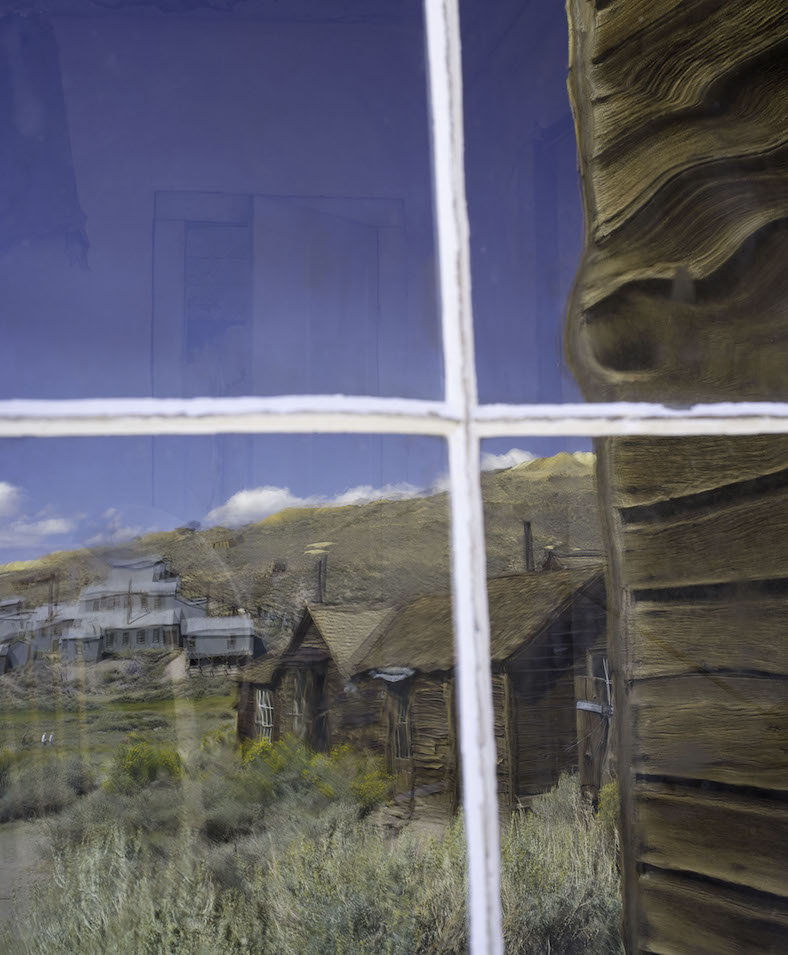
Original ‘wavy’ glass reflects the Standard Mine in Bodie. Photo by Kerrick James
The Bad Men of Bodie
Bodie, California was founded early in 1859, a decade after placer gold mining began on the west side of the Sierras. But it truly boomed in 1876 when a rich vein suddenly appeared in a cave-in. From that point on Bodie was a hard-rock gold town, 8,400 ft. up due east of the Sierra crest, 75 miles southeast of Lake Tahoe.
Bodie was renowned as a tough town and became infamous for the “bad man from Bodie” moniker. By 1879 some 10,000 people lived and worked there.
One sure measure of a mining town’s size and prosperity was its number of saloons, and Bodie boasted 65 on Main Street. The gold ore thinned out in 1881, with a resurgence in the 1890s followed by a long, slow decline until the last mine closed in 1942 following a WWII edict ordering the closure of all non-essential gold mines.
Bodie once boasted 2,000 structures, but only 110 or so remain today, after a devastating fire in 1932.
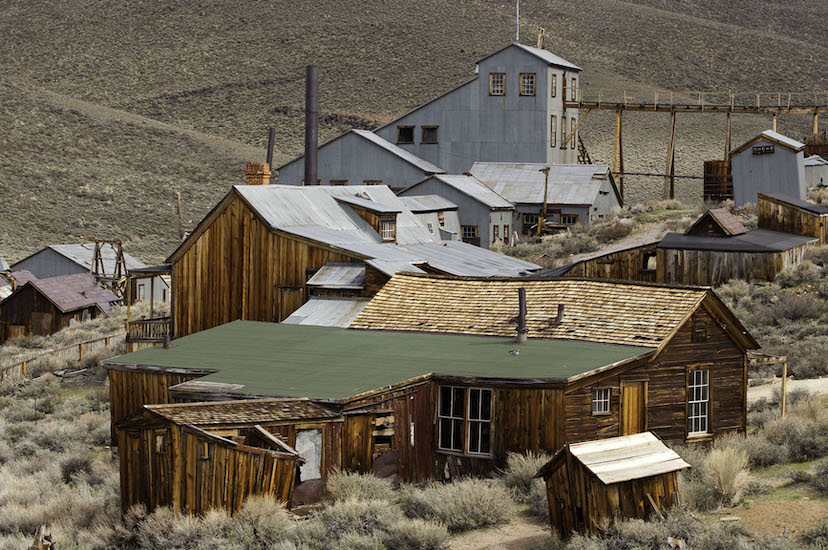
The Standard Mine still survives in Bodie, a once wealthy mining town that today is administered as a State Historic Park in California. Photo by Kerrick James
Today it lives on in a ‘state of arrested decay’ as a California State Park administered by the Bodie Foundation. A variety of tours are offered but you can also wander the streets alone and peer through windows of wavy glass, imagining the noise and ruckus of the miners filling the saloons before heading upstairs to the busy brothels. Bodie is an unnaturally cold place. The winter of 1878-9 froze many residents to death. During some parts of the year, winds up to 100 mph still scour some of the mountain passes. So, bring a coat for night tours, even in summer.
I’ve been going to Bodie since the 70s, and it still seems largely the same, which is a victory for preservation. Bodie was my first real ghost town of scale and fired my resolve for future explorations of many a broken-down mining town from New Mexico to Alaska. Eventually, I photographed a book called Ghost Towns of the Southwest, and still lead photo workshops to those hardy survivors.
I’m perennially drawn to lonely locales where dreams drove men and women, young and old, to risk all they had for a chance at wealth and some measure of happiness. Only a few seekers became rich, while many miners died underground, or at the hands of robbers and killers. But their spirits still seem to inhabit places like Bodie, and I always say hello to them when I go back. Be sure to walk over to the graveyard and study the weathered markers before you head out to warmer and safer climes.
Bodie State Historic Park in summer is open from 9 a.m. to 6 p.m. Winter hours are from 9 a.m. to 4 p.m. Adults pay a $8 entry fee; children ages 4 – 17 cost $5. For additional information please consult the Bodie Foundation for information on tours and other things to do.
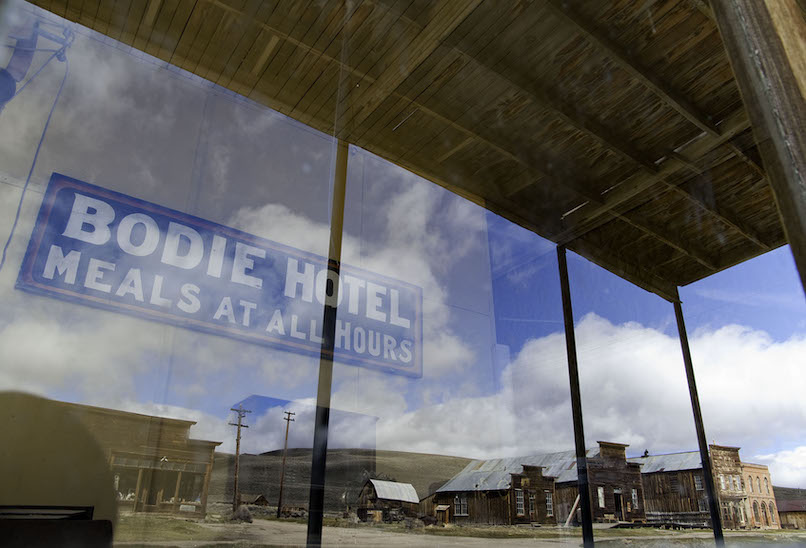
The Bodie Hotel window reflects a lonely Main Street vista. Photo by Kerrick James
Ruby on the Mexican Border
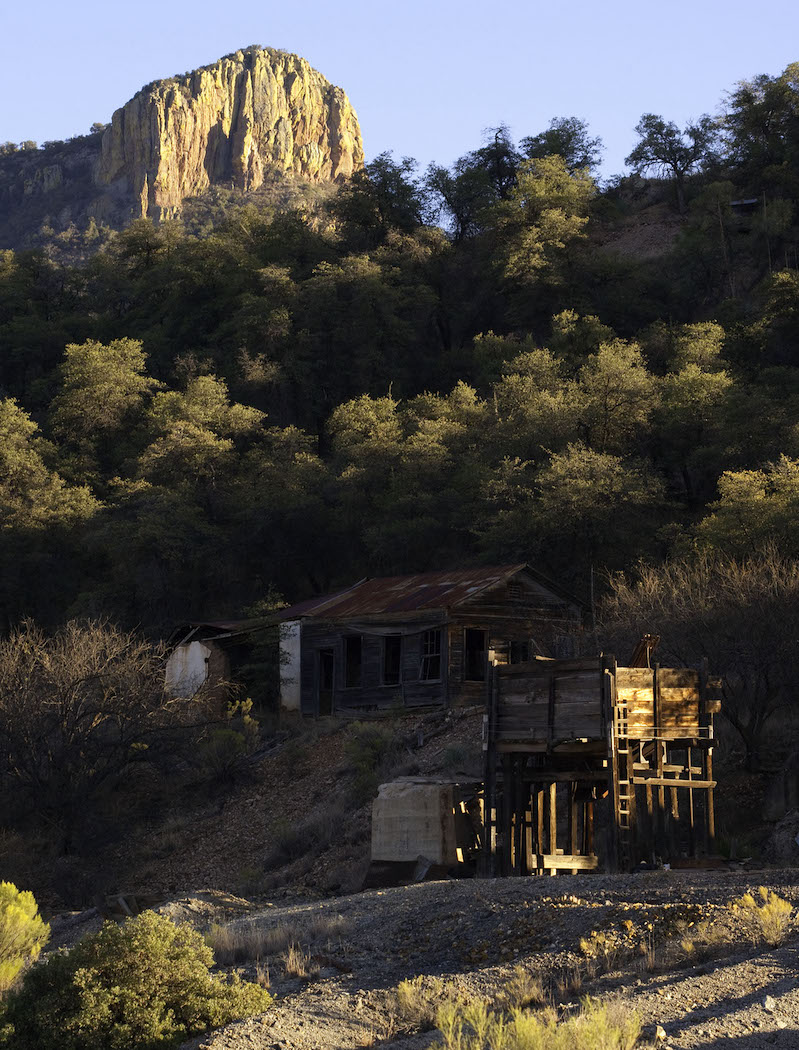
Mine head-frame below Montana Peak, late afternoon at Ruby. Photo by Kerrick James
Yet another evocative mining camp turned ghost town is Ruby, Arizona. Located far to the south 30 miles northwest of Nogales near the Mexican border, Ruby owes its existence to deposits of gold, silver, lead, zinc and copper. It is much quieter and less well-known than Bodie, which is one of its charms. Mining began here in 1877 in the shadow of Montana Peak, just about the time the Apache became less of a physical threat to operations. In 1891, a large body of high-grade silver-lead ore was discovered in the Montana Mine, assaying at 80-90 ounces of silver to the ton. This bonanza helped mining to continue through the late 1930’s. Then, in 1941, Ruby was abandoned.
Today, Ruby is privately owned, but visitors are welcome. The $15 p/p entry fee gives you a map of Ruby, a day pass, and access to over 350 acres of trails in this scenic little valley. Some adobe walls survive, melting into the grass, along with several quite attractive weathered old trucks, a schoolhouse, mine offices, a warehouse, an infirmary and a few homes. Bring your own snacks and drinks, as you’ll want to spend some time here exploring, though one area is off-limits due to collapsing mine tunnels and drifts. Ruby sits at 4,186 ft. elevation and rattlesnakes can be found throughout the property, so be watchful.
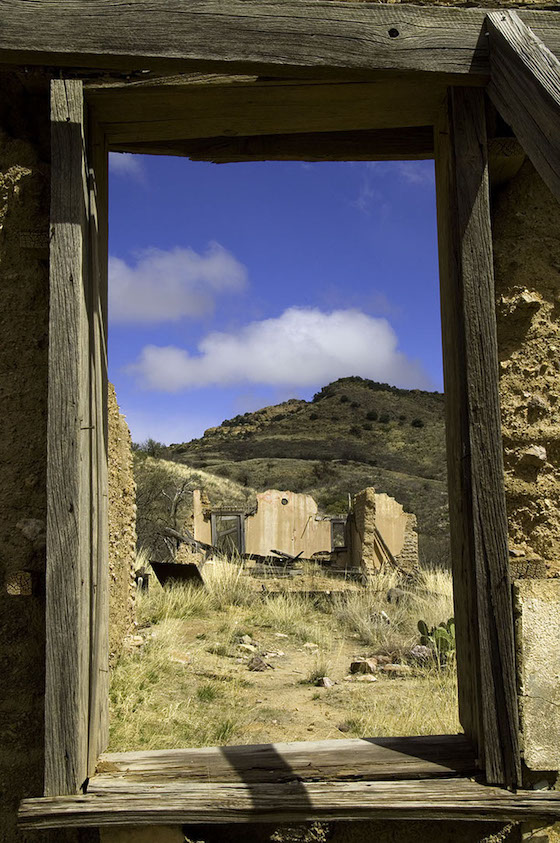
An empty window frame in the Ruby Mercantile Bank. Photo by Kerrick James
My lasting impression of Ruby is one of quiet and peaceful beauty. But this little mining town, which once had 1,200 inhabitants, was the scene of three horrific double murders in the early 1920s. Being just four miles from Mexico, Ruby was plagued by raids from bandits. The ‘Ruby Murders’ resulted in the deaths of many innocents and prompted the largest manhunt to that point in Arizona history. It even involved the first airplane to ever be used in a manhunt. A compelling account of the crimes and the search and eventual successful capture of the bandits can be found at Legends of America.
The first step toward traveling 114 years back in time will take you to the Ruby, Arizona website where you can request a permit. Do not expect to drive up and access Ruby without obtaining their permit in advance! They’re open Thurs.-Sun. from 9 a.m. to dusk. Also, bring exact Cash, as there is no bank in Ruby, (not anymore). If you stay into dusk, you can watch an early moon rise over the town as time slips away and you can almost hear the miner’s kids laughing and sliding down the skinny slide at the schoolhouse.
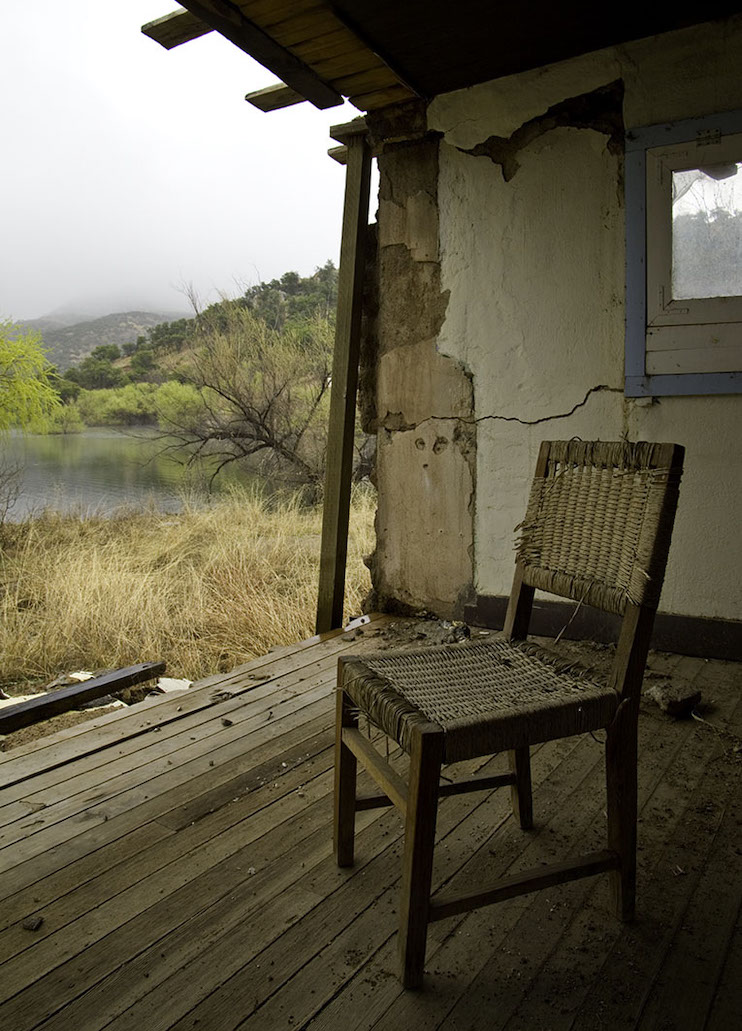
The lake view from a home in Ruby. Photo by Kerrick James
History Lives Next to a Spectacular Gem Mine
Last but surely not least is the rich photographic resource of Castle Dome City, which rests east of the Colorado River at an elevation of 1,352 ft. some 42 miles (1 hour) north of Yuma. The low elevation and the town’s Sonora Desert location means it’s quite hot in summer, so the best months to visit are October to April.
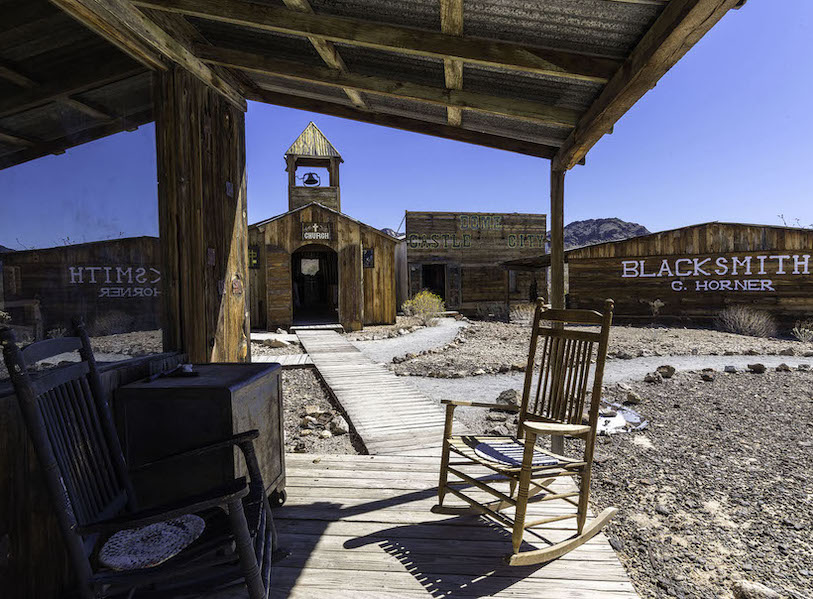
Boardwalks link the buildings In Arizona’s Castle Dome City. Photo by Kerrick James
This is a ‘recreated’ ghost town, preserving photogenic buildings and artifacts moved from over 300 mines in the area. Though not anywhere near as well-known as silver districts like Virginia City, Nevada, (of Big Bonanza fame), the Castle Dome mining district was quite rich in silver and hugely productive in lead. The lead was used for bullets and meant that Castle Dome was actually on Japan’s WWII bombing list if they ever should get close enough to drop explosives.
As we know, they never did reach Arizona, and today the town is a wonderful open-air museum with over 50 weathered wooden buildings, stuffed with bottles and paraphernalia from bygone times. For $ 20 you can enter and photograph to your heart’s content, in the jail (with cell and steel doors), hotel, five saloons, church, blacksmith shop, and much more. It is eye-popping and feels like a Hollywood stage set, but it happens to all be genuine pieces, not props.
The very land that sits beneath Castle Dome City has been a patented mining claim since 1871, and Castle Dome is the longest-worked mining district in Arizona. Because of that, the owner of this exceptional project, who is a bonafide hard-rock miner, reopened the historic Hull Mine in order to share with visitors an authentic silver-lead mine.
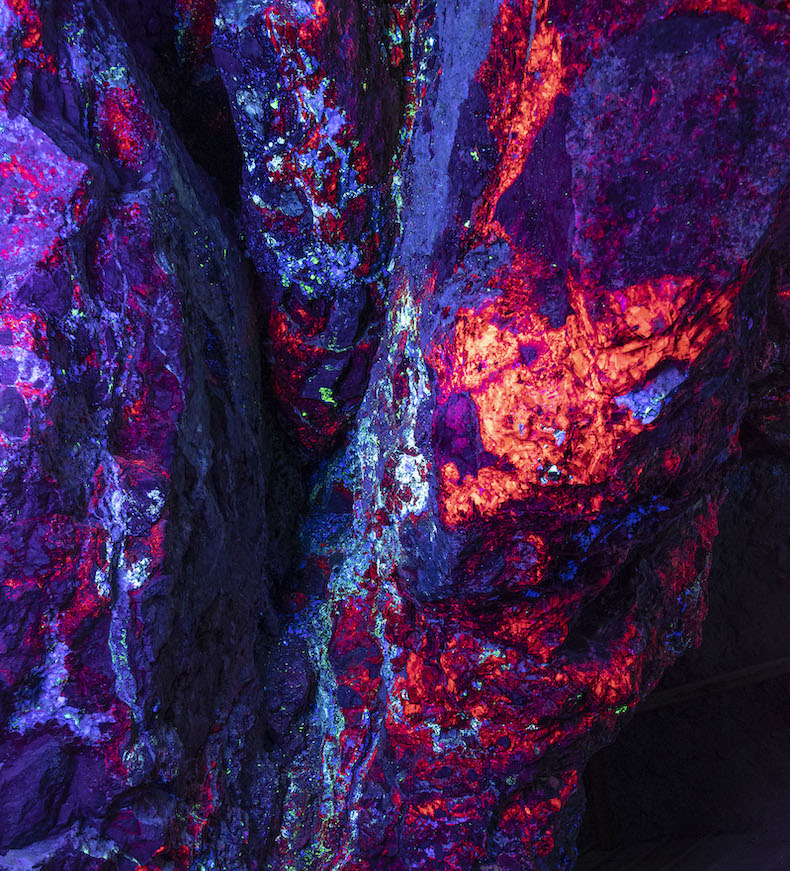
An array of fluorescent minerals is lit up inside the Hull Mine, Castle Dome City, AZ. Photo by Kerrick James
Deep inside this safe and scenic mine, which after its own inspection the U.S. Occupational Safety and Health Administration (OSHA) called the “Cadillac of mines”, you can view and photograph the ‘Arizona Fluorescent Mineral Wall.’ This rare stope, or mined-out area, is lined with a great variety of fluorescent minerals and when they turn on the powerful spectrum-tuned lights, this space becomes Aladdin’s Cave, on steroids.
You can capture an astonishing array of colors, even with a cell phone. I used an iPhone 13 ProMax, but any late-model phone should work. If you love minerals, see them as treasures of the Earth, and have an affinity for fluorescent minerals in particular, this alone is reason to visit. It’s one of just two ‘color caves’ like this is the USA, with only a handful existing around the world. And it’s a steady 70 degrees inside the mine, most welcome on blistering summer afternoons in southern Arizona.
The Castle Dome Mine Museum offers a daily tour of the Hull Mine, at 1 p.m., in season, and custom tours as well, but those should be pre-arranged. You’ll also see pairs of ancient miners’ Levi’s in a side tunnel, which are remarkably small. I guess even miners were smaller folks back then. The 2023 cost for the guided Hull Mine tour is $75 cash or $80 with a credit card, which includes the museum entrance, saving you $20. The last seven miles of road into Castle Dome City are dirt and it can be washboard, so drive easy and soon enough you’ll be there. Also, when looking online for directions don’t be fooled into going to Castle Dome Landing, which was sited beside the Colorado River to serve the needs of the mines.
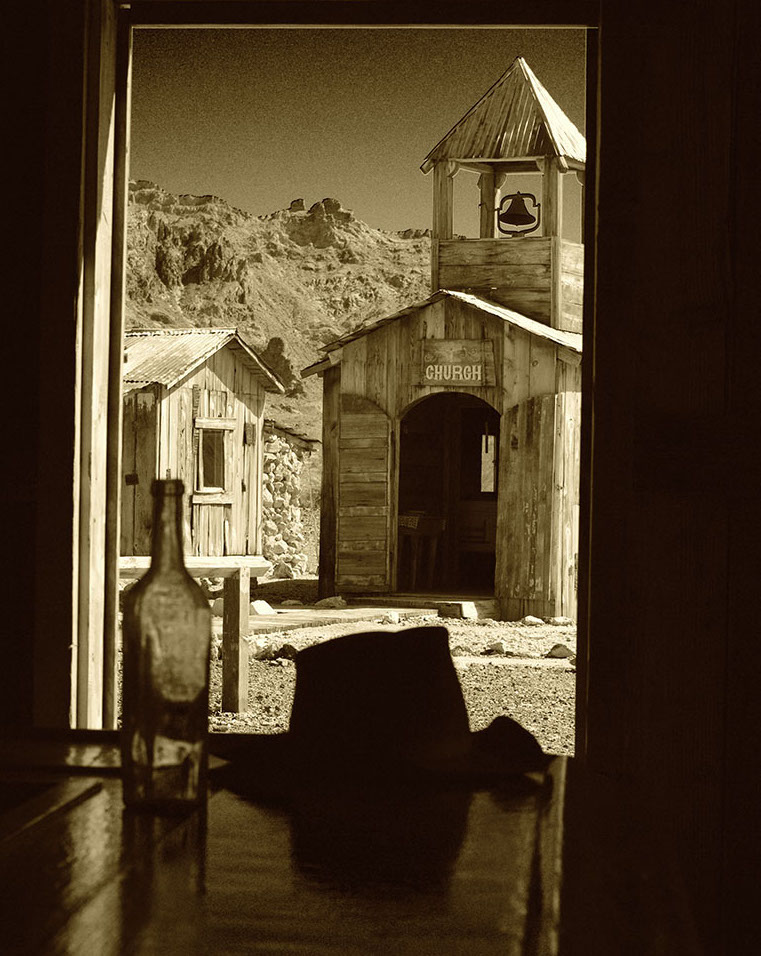
View of the church from the bar in Castle Dome City. Photo by Kerrick James
Every ghost town I venture to, whether extensively preserved or barely recognizable, has an aura of melancholy that resonates deeply within me. If you slow down, unplug from the web, breathe the air and feel the wind and sun on your skin, you will hear the rustle of loose roof metal, the drip of water down a dark shaft, even the hoarse call of circling ravens. You also may sense the raucous spirits of the dreamers who came out West long ago.
I sometimes imagine I can hear them laughing in the breeze, or sense them sighing when the last light of day paints the dry lonely landmark of Castle Dome peak, or Montana Peak above Ruby, or the ramparts of the Standard Mine at Bodie. Tip your hat to their memory, respect their devil-may-care, risk-it-all choices, and one day you’ll probably return to these ghost towns and perhaps discover other remote sites. Real people lived and died here, building lives that lead to the culture we’ve become out West. They should not be forgotten.
Kerrick James is an Arizona-based travel journalist with over 200 published book and magazine covers to his credit. He has taught more than 100 photo workshops in places ranging from Alaska and Mexico to Panama and Zambia. In May 2024 he will offer a four-day workshop that will visit “Ghost Towns & Mines of Southern Arizona.” Customized personal photography trips also can be arranged by visiting KJ Photo Safaris.

